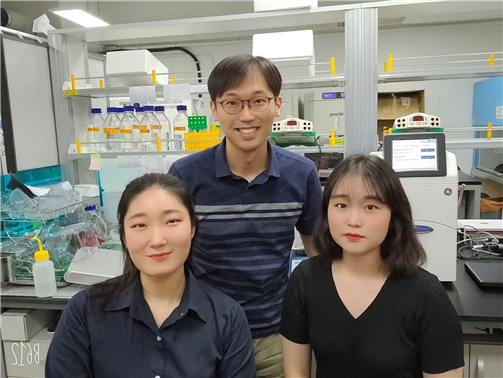Research Team Led by Jae-Hoon Jung, a Professor at the Department of Biological Science Identifies a Prison-like Domain in ELF3 Functions as a Thermosensor in Arabidopsis

[Image 1] From the left, Sujeong Baek(Co-author), Jae-Hoon Jung(First author), Sol-Bi Kim(Co-author)
The research team led by Jae-Hoon Jung, a professor at the department of biological science announced that they have discovered for the first time in the world that ELF3, a plant prison-like protein, functions as a temperature sensor through a phase separation process.
This research was supported by the Korea Research Foundation that provides financial support to new study in science and technology field. In addition, the research was published in global journal, ‘Nature’ on August 27 (Thur) online.
*Title: A prion-like domain in ELF3 functions as a thermosensor in Arabidopsis
*Author: Jae-Hoon, Jung(First Author), Antonio D. Barbosa(First Author), Stephanie Huntin(First Author), Sol-Bi Kim(Co-author), Sujeong Baek(Co-author), Philip A. Wigge(Corresponding author)
Plants begin to bloom in warm spring after the winter. Even in winter, when the day gets warm, we often see some flowers bloom. But how do plants perceive temperature? Professor Jae-Hoon Jung’s research team, along with a team of researchers from Germany’s Leibniz Institute, Cambridge University, and Grenoble University, released the results that could answer the questions.
The research team focused on how ELF3 (Early Flowering 3) recognizes temperature changes, which is an important factor that constitutes a plant biological clock and is known recently as a factor needed to control plant temperature reactivity.

[Image 2] The protein complex with ELF3 stably performs the transcription suppression of the target gene at low temperatures. At high temperatures, isolation occurs where ELF3 protein is phase-separated, thus inhibiting the protein complex. As a result, the flowering of plants is facilitated at high temperatures.
The research team noted that part of the ELF3 protein in the Arabidopsis, a model plant, has a similar structure to the prion protein. Prion is well known for causing neurological diseases such as mad cow disease, but prion-like proteins found in animals, plants and even fungi are known to be involved in various physiological controls in cells. Through prion-like structures, ELF3 can function as a temperature sensor that can reversibly switch between active and inactive depending on temperature.
Depending on the presence or absence of prion-like structures, ELF3 has a completely different temperature response. In particular, ELF3, which includes a prison-like structure, shows a phase separation structure in the form of water droplets as temperature rise. Within these liquid aggregates, ELF3 is isolated, which causes ELF3 to tail to function normally. Through various experiment and analyses, the research team proved that the physical and chemical change called phase separation of ELF3 protein is a key mechanism for controlling the temperature reactivity of plants.
More than 500 prion-like proteins have been found inside the Arabidopsis, a model plant, and due to the nature of prions that are sensitive to temperature, the majority of these proteins are expected to function as temperature sensors such as ELF3.
Professor Jae-hoon Jung said, "With global climate change and rising temperatures, crop yields are gradually decreasing. Prion-like proteins found in all plants can be an important engineering target in the breeding program for the development of high-temperature resistance varieties."
※ Original Article: https://www.nature.com/articles/s41586-020-2644-7
